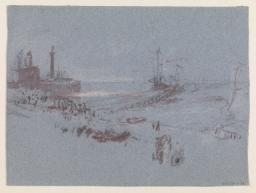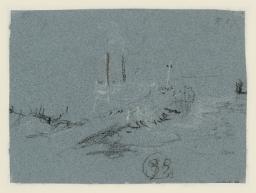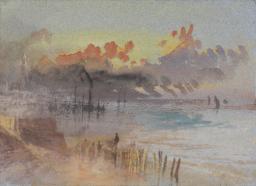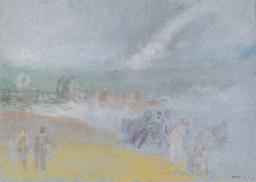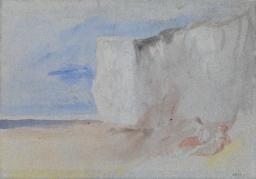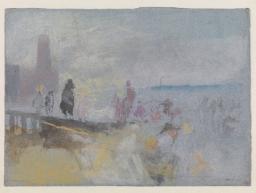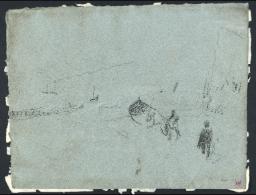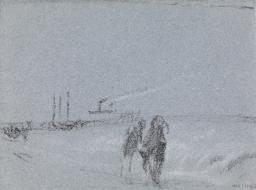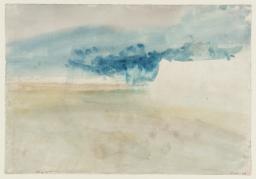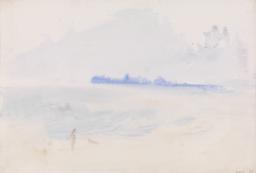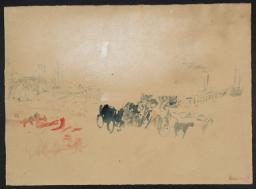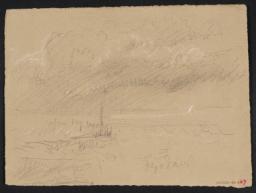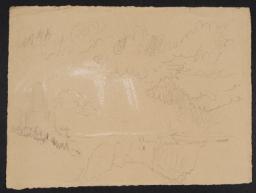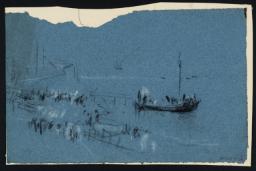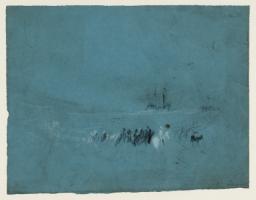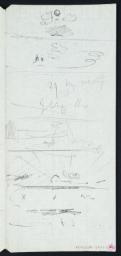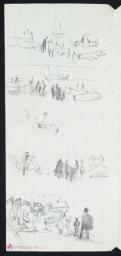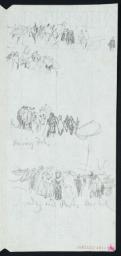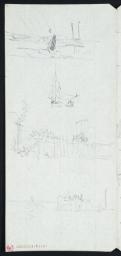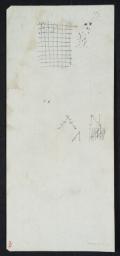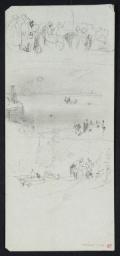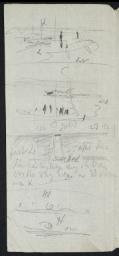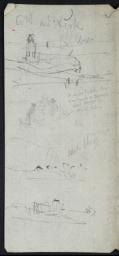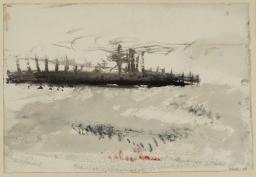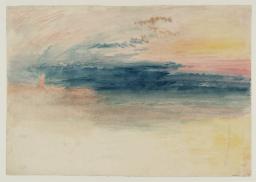Turner Bequest CCXXIV 29, 29v, CCLIX 75, 229, 247, 269, CCLX 111, 112, 218, 232, CCXCII 63, CCCXLI 427, 427v, CCCXLIII 26, 35, 36a–e, CCCXLIV 132–134, 190, 190v, 191, 191v, CCCLXIV 173, 210, 231
Turner’s long-standing familiarity with Margate in Kent, facing north at the seaward end of the Thames Estuary, is described in the Introduction to the Marine Dabblers sketchbook (Tate; Turner Bequest CCXLI), elsewhere in the present section.1 The selection of separate drawings and watercolours here shows scenes recorded in the vicinity of the house belonging to Mrs Booth, Turner’s landlady and eventually his companion, and some may have indeed have had the building as their viewpoint. Her semi-detached, double-fronted, three-storey seaside house once stood on the Bank Side quay, running north-east from the town’s stone pier past Cold Harbour, a small court or cul-de-sac south-west of the house, as shown in detail in the 1873 Ordnance Survey ten feet to one mile map. Mrs Booth’s (there labelled ‘Harbour House’) faced north-west over the brief but grandiosely named Great Beach. Droit House (or the Droit office), a small customs building with a distinctive cupola which still survives in much-renovated form at the start of the pier, was within sight to the left, aligned with the lighthouse to the west-south-west beyond.
Just past Mrs Booth’s neighbour to the east were steep steps up to Fort Parade, which led round to Paradise Street, meandering westwards back down to the harbour. The Fort Hill road follows the route of Paradise Street today, but the enclave between there and the shore was completely swept away, as was Fort Point, the little headland of chalk cliffs which enclosed the north-east end of the Great Beach, projecting north from where the lifeboat station now stands. Early twentieth-century maps show a car park on the Rendezvous, a broad quay built over the beach and reclaimed from the sea running east-north-east between Droit House and Fort Hill; comparison with modern plans shows that Mrs Booth’s house once stood at the centre of the Turner Contemporary gallery complex which opened in 2011.
Turner’s view from the house would have been dominated by a somewhat ramshackle oak jetty a few metres to the west. Known as Jarvis’s Landing Place, it was completed in 1824, and ran north from the Great Beach nearly a quarter of a mile into the bay, to a platform beyond the low tide line allowing access for larger vessels such as the passenger steamers from London by which Turner customarily travelled to the popular resort. In his time it was a low-level structure (such that the walkway was sometimes partly submerged at high tide) which included a fenced-off causeway curving south-west up the beach, as shown for example in a hand-coloured etching of Jarvis’s Landing Place after Varlo (impression at National Maritime Museum, Greenwich), to meet the landward end of the stone pier through a cast-iron arch near Droit House. In the 1850s the structure was rebuilt in iron at a higher level,2 and provided the vantage point for a photograph of Mrs Booth’s house and its immediate environment including the vanished Fort Point.3
Fortuitously, William Daniell (1769–1837) climbed Fort Point to record the view shown in his 1823 mezzotint of the Pier at Margate (Tate impression: T02945) for his Voyage Round Great Britain project, encapsulating the scene including Mrs Booth’s house, with its first-floor bay windows and flat roof immediately beyond the taller building in the left foreground, albeit shortly before Jarvis’s jetty was built. Turner’s experience of the scene would have encompassed busy times of passengers embarking and disembarking from the steamers, the local comings and goings of the many small boats shown drawn up on the beach in Daniell’s view, and quieter times at each end of the day, when the alignment of the house would have given particularly good views of summer sunsets, looking west over the bay and up the estuary. James Hamilton has noted ‘Turner’s fascination with the marine and human activity there’ and suggests that some ‘Margate studies come closest in their general character to studies of the French and German rivers. There is the same bustling, peaceable activity, made the more appealing to him through familiarity and enjoyment.’4
Indeed, there are numerous studies here on small sheets of blue paper (Tate D20319, D20320, D24640, D24794, D24812, D24834, D24947, D24948, D34326, D34336; Turner Bequest CCXXIV 29, 29v, CCLIX 75, 229, 247, 269, CCLX 111, 112, CCCXLIII 26, 35), which Turner first used extensively in France in 1826, on the Isle of Wight (mostly Tate; Turner Bequest CCXXVII a, CCXXVIII) and at Petworth House (mostly Tate; Turner Bequest CCXLIV) in 1827, and for datable Continental subjects as late as 1840. There may be others without Margate landmarks in the present author’s ‘Figures on a Beach c.1826–45’ section, the Introduction of which discusses the technical aspects and gives a broader sense of Turner’s engagement with those at work or leisure beside the sea. There are also two sheets of buff paper (Tate D29014, D34160, D34161; Turner Bequest CCXCII 63, CCCXLI 427, 427v) the second of which includes a small sketch suggesting interest in new developments in Kent’s transport network in 1844.
There are also small folded sheets of notepaper which seem to have been bundled together as inconspicuous ad hoc sketchbooks (Tate D34337–D34341, D34493–D34495, D34582–D34585; Turner Bequest CCCXLIII 36 a–e, CCCXLIV 132–134, 190–191v) with visual and written notes of all sorts of activities as well as sky and landscape studies, some of which definitely show Margate, and a few larger sheets of the ‘colour beginning’ type (Tate D25340, D25354, D36017, D36056, D36077; Turner Bequest CCLXIII 218, 232, CCCLXIV 173, 210, 231), at least one of which clearly depicts the pier. Finally, there is a late, elegiac view of what is probably the town in the distance at sunset, which left Turner’s studio before being acquired for the main Tate Collection (N05239).
There may well be other Margate views among the unspecified ‘Coastal Scenes and Shipping ?after 1827’ works covered in this catalogue by John Chu. Andrew Wilton has noted various works outside the Turner Bequest which again may include scenes in Margate and its vicinity (and are occasionally identified specifically as such), including a watercolour known as Sunrise off Margate (private collection),5 works on blue or grey paper from the 1830s,6 others from perhaps the same period often made on buff paper,7 and slight but evocative studies of sunset and clouds over the coast and sea on white paper.8 Edward Yardley attempted a reconstruction of a Margate ‘sketchbook’ including some of the buff paper studies mentioned by Wilton together with further similar sheets, dating them to the second half of the 1840s;9 at least some of these separate works had originated in an actual sketchbook bought from Mrs Booth by John Ruskin.10
In terms of dating, the blue paper works here are placed between about 1829, the earliest likely date of the Margate-related Marine Dabblers sketchbook noted above, and 1840. The range applied to those on white paper has been extended to about 1845, the year of Turner’s last extensive use of colour in his sketchbooks on is final excursions to France and the excursions around Kent recorded in the Near Folkestone (?), Hythe and Walmer, Ideas of Folkestone, and Dieppe and Kent, sketchbooks (Tate; Turner Bequest CCCLIV, CCCLV, CCCLVI, CCCLXI); the small Channel sketchbook now at the Yale Center for British Art, New Haven, also belongs to about 1845, and includes one or two Margate views. The small folded sheets in the present section are on paper by a manufacturer recorded in business from 1831 onwards, so that year has been used as a starting date, again ranging as far as 1845. In the following year Turner moved to Chelsea with Mrs Booth and her son,11 although there were extended trips to Kent subsequently,12 and the artist was recorded as being in Margate again as late as September 1850,13 little over a year before his death.
See also Joanna Selborne, ‘Sand, Sea and Sky: Margate and Ruskin’ in Selborne, Andrew Wilton and Cecilia Powell, Paths to Fame: Turner Watercolours from The Courtauld Collection, exhibition catalogue, Wordsworth Trust, Grasmere 2008, p.132–3.
For the development of the landing place see Janet Robinson, ‘A Branch of the Jarvis Family: 7. Daniel Jarvis (3rd)’, Margate in Maps and Pictures, accessed 8 August 2016, http://www.margatelocalhistory.co.uk/DocRead/Jarvis%207%20Daniel%20Jarvis%203rd.html , and for engravings and photographs, see slideshow, ibid., http://www.margatelocalhistory.co.uk/HotSpotViewer/EdmundsPics/Jarvis%20Landing%20Place.html?zoom_highlight=jarvis+landing+place ; see also Selborne 2008, p.134.
Bernard Falk, Turner the Painter: His Hidden Life, London 1938, reproduced opposite p.206; for this and other photographs (many showing Mrs Booth’s house and the beach, cliffs and jetty in the nineteenth century), see slideshow, Margate in Maps and Pictures, accessed 8 August 2016, http://www.margatelocalhistory.co.uk/HotSpotViewer/OSLargeScaleMapPics/Bankside.html .
Andrew Wilton, J.M.W. Turner: His Life and Work, Fribourg 1979, p.391 no.784, as c.1825–30, reproduced.
How to cite
‘Margate Beach Scenes c.1829–45’, subset, in David Blayney Brown (ed.), J.M.W. Turner: Sketchbooks, Drawings and Watercolours, Tate Research Publication, December 2016, https://www

